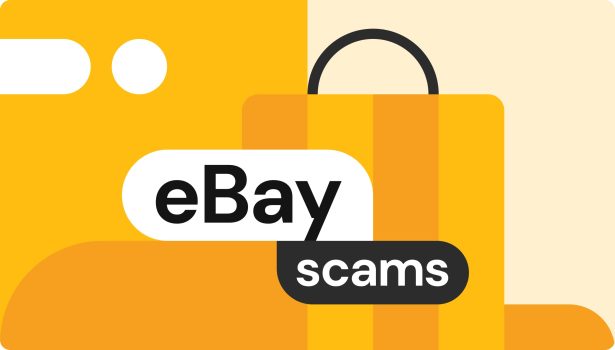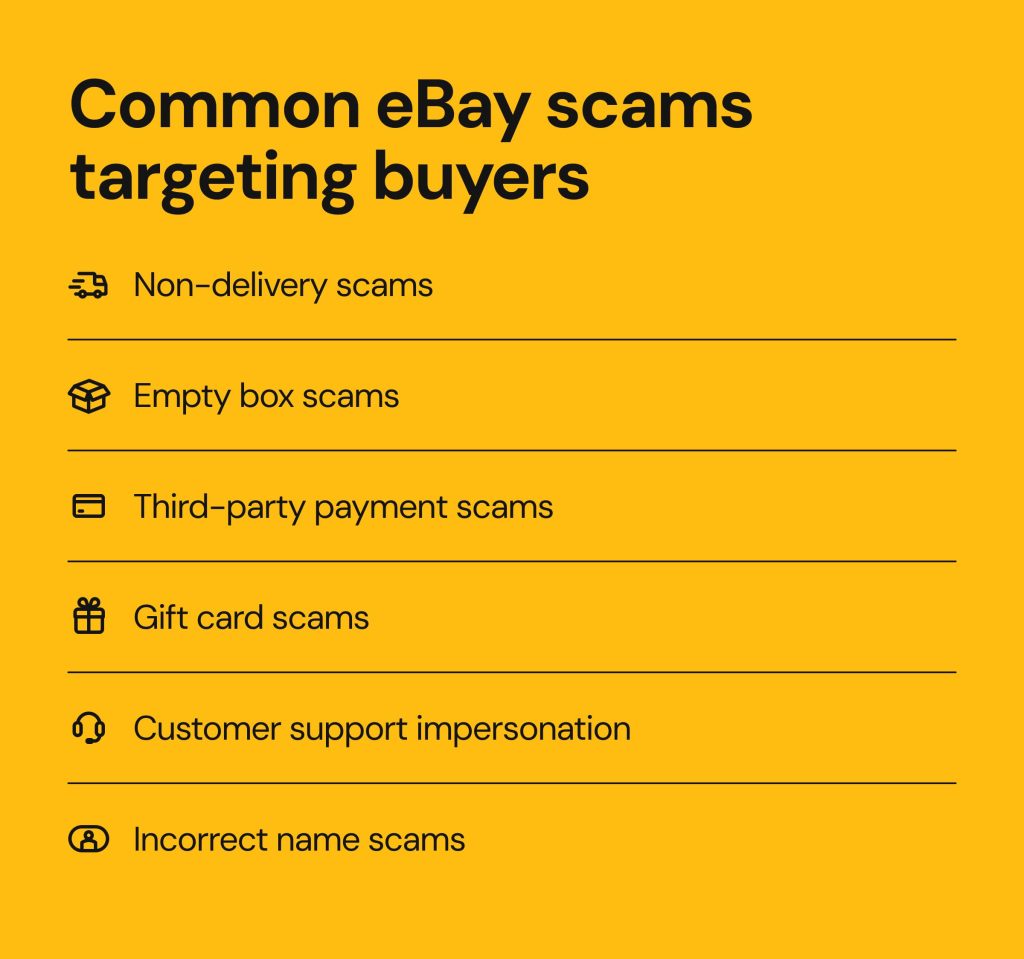eBay scams: how to recognize, avoid, and report them

As the world’s third most visited marketplace, eBay has put numerous safeguards in place to protect its users. But for every legitimate, mutually beneficial transaction, there is an opportunity for scams, tricks, and deceptive schemes to slip through.
Let’s look at the most common eBay scams going around, how to spot them for both sellers and buyers, and what to do if you happen to be a victim.
Can you really get scammed on eBay?
Yes, and it’s easier than most people think. eBay scams target both sellers and buyers, and the platform acts only as a middleman, which makes it easier for fraudsters to vanish without consequence.
Common eBay scam categories include phishing, non-delivery, counterfeit products, and schemes targeting items not covered by buyer protection, such as digital goods or services.
Scammers can also exploit tactics such as empty boxes, photo-only listings, and overpayment scams. These schemes have been around since eBay launched in 1995, and they are only becoming more sophisticated over time.
Common eBay scams targeting buyers
A quick shopping spree can turn into a costly mistake if a scammer tricks you into handing over your money, payment details, or personal information. So if you wonder: “Can I get scammed on eBay?”—here are some of the most common schemes targeting buyers:
Non-delivery scams
This type of eBay scam happens when a buyer pays for an item that never arrives. In some cases, the scammer provides fake tracking information to buy time or make the transaction look legitimate. Other times, they disappear entirely after receiving the payment, ignoring all communication.
This scam is especially frustrating because buyers are often left without the item or a refund, particularly when the purchase falls outside of the eBay Money Back Guarantee. Scammers exploit these gaps by targeting categories with limited enforcement or coverage, such as digital content, services, travel vouchers, or event tickets.
Empty box scams
Although empty-box scams can affect both sides of a transaction, they most often target buyers. In these cases, a buyer pays for an item and receives a package that arrives on time with valid tracking, but the box is empty. Some scammers even match the expected weight to avoid raising suspicion.
Another variation of the scam involves shipping the item to a nearby but incorrect address. The tracking status shows “delivered,” but the buyer never gets the item. Since eBay’s refund process heavily depends on tracking information, it becomes difficult for the buyer to prove they have been scammed, especially if the packaging looks untampered.
Third-party payment scams
In this scheme, a fraudulent seller convinces the buyer to complete the transaction outside of eBay, often through wire transfers, prepaid cards, cryptocurrency, or third-party apps like Venmo. The scammer might offer a discount or claim off-platform payment is faster and safer.
But once the money is sent, the item never arrives, and the buyer has no official eBay record of the transaction to dispute. Since eBay’s protection policies apply only to purchases made directly through the platform, these scams leave buyers with little to no recourse.
Gift card scams
The setup usually begins with an eBay scam seller pushing for payment via eBay gift cards instead of using eBay’s secure checkout. They often create a sense of urgency, saying the item is almost sold out or only available for a short time, to pressure the buyer into sending the card details quickly.
Once the buyer sends the gift card details, the scammer wastes no time redeeming the balance and disappearing. Since the payment never goes through eBay, there’s no official record of the purchase and no way to open a dispute. The buyer is left with nothing: no item, no refund, and no recourse.
Customer support impersonation
Some scammers pretend to be eBay’s support team, reaching out about supposed problems with your account or a recent payment. To appear credible, they might reference recent activity or use professional-sounding language—then ask you to confirm personal or payment details under the guise of resolving the problem.
The pressure to act quickly is part of the trap. Once they get access to your sensitive information, like credit card numbers, login credentials, or your address, it can be used for identity theft, further scams, or sold on the dark web.
Legitimate eBay representatives will never ask for full payment details or passwords. If you’re unsure, always verify messages through eBay’s official help channels before sharing anything.
Incorrect name scams
While it might seem like an honest mistake, this scam involves a seller using a fake name on the shipping label in hopes that the buyer will reject the package. If the item is returned because the name doesn’t match, eBay’s Money Back Guarantee no longer applies. The scammer keeps both the money and the product, leaving the buyer with nothing.

Common eBay scams targeting sellers
Sellers can also be scam targets, as eBay tends to side with the buyer in questionable cases. Here are some typical scam schemes that sellers may fall into:
Broken item scams
This scam occurs when a buyer falsely claims that a received item is damaged, often after the return window has closed. The scammer may demand a partial refund or return the item for a full reimbursement. In some cases, they send back an item in worse condition, or even a completely different, cheaper one. If the seller can’t prove the original item was in good condition when shipped, eBay often sides with the buyer, forcing the seller to issue a refund.
Chargeback scams
This scam often catches sellers by surprise. After receiving the item, the buyer disputes the charge with their bank or credit card company, claiming it was unauthorized or that the product never arrived. If the chargeback is approved, the refund is pulled from the seller’s account. The buyer ends up with both the item and the money, while the seller is left with nothing.
Overpayment scams
This scam occurs when the buyer “accidentally” overpays for an item and then asks the seller to return the excess amount. In reality, the buyer has no intention of completing the purchase—the original payment is either recalled or bounces, leaving the seller without both the item and the money.
Changed address scams
As a new twist on the overpayment offer, buyers can offer to purchase your item and send a larger payment than the listed one. They claim it’s to cover additional shipping costs, as they suddenly need the item to be sent to a foreign country.
Then the eBay scam buyer asks for your PayPal address so you can later be contacted by a “PayPal representative,” requiring postal tracking numbers. The email often states the payment will be released to you once you prove the shipment. As a result, the seller, trusting in the authenticity of the email, ends up shipping the item without ever receiving the actual payment.
Feedback extortion scams
eBay acts as an intermediary, so building an online reputation for sellers is important. Each transaction opens the opportunity for both sellers and buyers to leave public feedback about the experience. No one would want to trade with accounts that have bad feedback.
Knowing this, scammer buyers can purchase your product and then demand money to be sent through private means, threatening to leave bad feedback on the seller’s account. Since completed feedback can’t be disputed, this type of blackmail places some sellers in a position where they must either comply or risk their reputation.
How to spot a potential eBay scam
All eBay schemes are different, but most of them can be spotted early by watching out for common warning signs:
Warning signs of seller fraud (for buyers)
Seller eBay scams usually follow the same playbook as other online marketplace schemes. A general rule is to spend 10 extra minutes verifying the legitimacy of the seller rather than quickly sending money and expecting a package that may never arrive. Some red flags that can indicate a fraudulent seller include:
- Fake listings: posted for a short duration, often with misleading information, small disclaimers in photos or descriptions, or prices that seem too good to be true.
- Payments via untraceable methods and outside eBay: the seller requires you to contact or pay them outside of eBay, even though that’s the only way to ensure you’re protected by eBay’s Money Back Guarantee.
- Little to no feedback history: although it might signal just a new legitimate seller, it’s still important to be wary of those without a reasonable feedback history.
- A seller suddenly listing more expensive goods: scammers sometimes sell inexpensive items to build reviews and boost their seller rating, then add high-priced products to trick buyers with their seemingly solid reputation.
- Unusually long shipping timelines: most products shipped within the country take a week or two. Prolonged delivery dates or high shipping costs could indicate you are dealing with a scammer.
Warning signs of buyer fraud (for sellers)
Although buyer fraud is less expected and often harder to notice, it can leave sellers empty-handed just as easily as seller fraud. Here are some key warning signs to watch for:
- Requests to pay outside of eBay: buyers may ask to pay using gift cards, cryptocurrency, wire transfers, or prepaid cards, bypassing secure systems and exposing you to risk.
- Buyers asking to change the shipping address: be cautious if a buyer asks to ship to an address that differs from a registered one, especially if it’s in another country.
- Any unusual requests: be wary of anyone asking for personal information unrelated to the transaction or trying to move the conversation off eBay.
- Overpayment or overly eager buyers: buyers who overpay or insist on paying more than necessary might be attempting to set up a scam.
- New buyers with suspicious activity: take a closer look if a buyer is repeatedly purchasing high-ticket items or ordering the same product multiple times.
What to do if you got scammed on eBay
Getting scammed on eBay can be frustrating, whether you’re a buyer or a seller. Acting quickly and following the right steps can improve your chances of recovering lost money or protecting your account from further damage. If you’ve been scammed by a buyer or seller on eBay, here’s what to do next:
- Start by requesting a refund or responding to a dispute: If you’re a buyer, open a refund request using the appropriate reason. If you used a third-party platform (like PayPal), file a claim there too. If you’re a seller, respond promptly to any buyer claims and prepare your evidence to challenge the dispute if it’s fraudulent.
- Report the scammer to eBay: use eBay’s Report a Concern page to officially file a complaint. This helps eBay investigate and take action against the account involved.
- Clearly describe your case with evidence: depending on the situation, include screenshots of communication, a signed note from the post office, photos of the item before shipping, or a video of you unboxing the package.
- Leave feedback: posting negative feedback can warn other users and impact the scammer’s reputation. Keep the tone factual and calm, whether you’re a buyer or a seller.
- Watch for signs of identity theft: if you clicked on a suspicious link or shared personal or payment information, stay alert. Monitor for credit report changes, unfamiliar charges, or unauthorized activity. Update your passwords, enable two-factor authentication, and consider removing your data from data broker sites to reduce the risk of further scams involving your personal information.
- Contact law enforcement: for scams involving significant financial loss or fraud, file a report with your local police department or a relevant cybercrime agency.
How to protect yourself on eBay
Avoiding potential fraud in the first place helps save you a headache, your reputation, and money further down the line.
Tips for buyers
Here is a checklist of safe shopping habits for eBay buyers:
- Carefully read the listing, understand the description, and review the seller’s return policy.
- Double-check the seller’s reviews, history, and inventory.
- Compare item pricing with other sellers, do not rush to choose the cheapest option.
- Communicate and pay only through eBay’s platform.
- Avoid sellers using high-pressure tactics and short-term offers that create a sense of urgency.
- Never click unknown links or share personal information, like gift card numbers and PINs, phone number, or email.
- Always track the shipment from the beginning and ask for proof of shipping if needed.
- Prefer items covered by eBay’s Money Back Guarantee for added protection.
- Be cautious of deals that seem too good to be true—scammers often use low prices to trick buyers.
Tips for sellers
eBay sellers should also know general safety rules when interacting with buyers:
- Avoid off-platform communication and payments.
- Never sell on someone else’s behalf unless you fully trust them, as you could accidentally become an accomplice to fraud.
- Consider using “Buyer Requirements” in My eBay to control who can bid on your items and prevent scammers.
- Cancel suspicious buyer transactions, but be sure to have a valid reason.
- Always confirm payments directly with your payment provider before shipping.
- Use trackable shipping and get proof of posting.
- Only trust refund requests sent through your My eBay Messages. Scammers may impersonate buyers through email or off-platform channels.
- Take a photo of the item before shipping to show it was sent in proper condition and to have potential evidence.
How Onerep can help
Avoiding eBay scams isn’t just about spotting red flags—it’s also about limiting what scammers can use against you. Fraudsters often pull personal details like your name, email, or phone number from public data sources to make their scams more convincing.
Onerep helps reduce your digital footprint by scanning the web and removing your personal data from people-search sites and data brokers. The less exposed you are, the harder it is for scammers to target you.
Start with a scan to see what’s out there and take steps to protect yourself before your data is used in a scam.
FAQs
Can you get scammed on eBay?
Yes, both sellers and buyers can be scammed on eBay. Some of the most common eBay scams include third-party payment scams, non-delivery scams, customer support impersonation, empty box scams, among others.
I got scammed on eBay by a buyer, what can I do?
File an incident report with eBay, contact the payment provider for a refund, collect evidence, leave feedback, watch for signs of identity theft, and contact law enforcement in cases of significant financial loss.
Does eBay refund scams?
In most cases, when supported by evidence, eBay tends to side with the buyer. So yes, it may refund money in a scam case, even if the seller is the victim. However, if communication and payment happened outside eBay, the chances of a refund are extremely low.
Is it safe to buy electronics on eBay?
In general, yes, but it’s important to follow safe eBay shopping practices. Before purchasing, verify the seller’s legitimacy by checking their ratings, reviews, account activity, and sales history. If a seller suddenly lists an expensive item after previously selling only low-cost ones, that can be a red flag. Always communicate and pay through eBay to stay protected.





Mikalai is a Chief Technical Officer at Onerep. With a degree in Computer Science, he headed the developer team that automated the previously manual process of removing personal information from data brokers, making Onerep the industry’s first fully automated tool to bulk-remove unauthorized profiles from the internet.